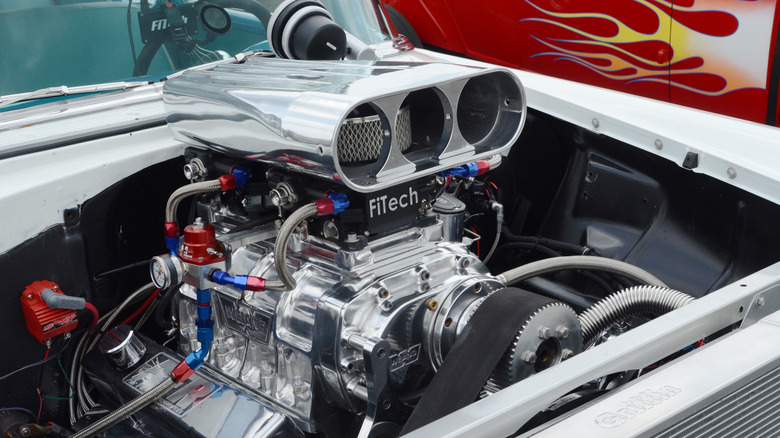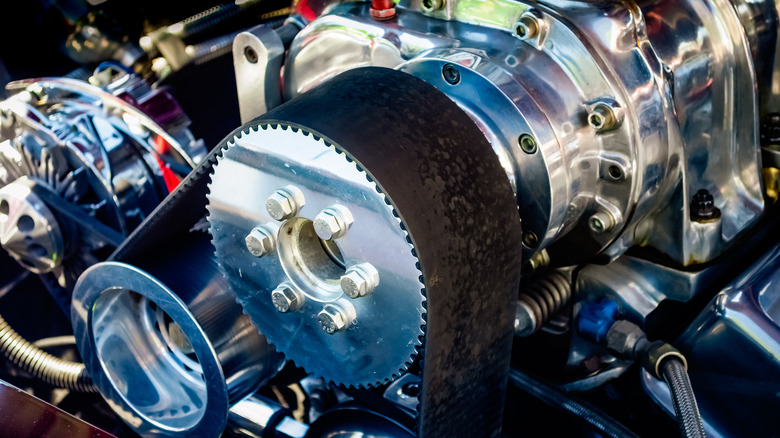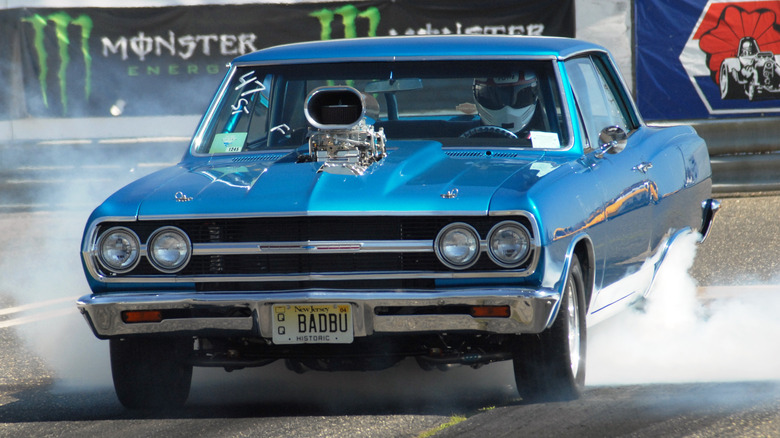Why Do Some Muscle Cars Have Blowers On The Hood? Here's What They're For
Roots-type blowers — which are different from centrifugal or twin-screw superchargers — frequently dominate the front ends of modified muscle cars and street rods, especially dragsters and similar purpose-built racing machines. They're not true superchargers in that they don't compress air. Instead, they force uncompressed air through the intake manifold like an air pump; we'll discuss how that's accomplished later. The ones you see on muscle cars usually feature three main elements: the blower's body, the fuel delivery system mounted on top, and the iconic intake scoop, also called a "hat" or "bug catcher." These elements may feature open faces or butterfly valves, with the valves opening and closing along with the throttle. Usually they're the most prominent features of the blower system, and are often visible above the car's hood line. So why do so many muscle cars have these, and what's their role in the process of generating horsepower?
To keep it simple, the scoop acts as a ram-air intake, drawing cool air from outside rather than the hotter air from the engine bay before mixing it with fuel. Hotter air is less dense than cooler air, and less density means less oxygen for the engine to burn in the combustion process. The scoop, therefore, merely acts as the first of a three-step process, drawing in and trapping clean, cool air to be mixed with fuel before it's finally picked up by the blower's intake. Let's explore this in greater detail.
The physics behind how Roots superchargers work
As previously mentioned, Roots blowers create additional power by first drawing in fresh air through the scoop and mixing it with fuel. This mixture then travels into the main body, which utilizes two rotors that spin in opposite directions. This accelerates the flow of the air along either side of the housing, forcing more air into the engine like a person continuously shoveling coal into a boiler. Ultimately this means you're now introducing far more fuel and air directly into the engine; check out the video below for a visualization.
Roots superchargers turn through the use of a belt connected to the engine's crankshaft, so it's always running along with the engine. The blower's operation produces a distinctive whine, which is common to Roots blowers as well as twin-screw superchargers like the one found on the Challenger Hellcat's engine. Normally, the drag created by such a system means that a blower actually draws power away from an engine at first. But the benefits of the extra available air once it's cranking vastly outweigh the drawbacks, resulting in a sometimes substantial net gain in power output. And because this extra airflow is not dependent on exhaust gases like a turbocharger, this power is available right off the line, making blowers especially popular choices for drag racers.
Why they're popular on muscle cars
The main reason why superchargers and blowers are so popular is because of their capacity to make a car more powerful. They represent a simple and effective means of cramming as much air as possible into an engine, and a Roots-equipped engine can produce excellent power relative to a naturally-aspirated one. Roots blowers are used for everything from mill generators and subway tunnels to water pumps, with automotive applications taking various forms. The ones used in drag racing typically derive their design from the 6-71 blower first used on GMC diesel engines. Roots blowers are named after inventors Philander and Francis Roots, and have evolved over time into the stealthier units found on modern muscle cars like the Camaro ZL-1 and Shelby Mustang.
Muscle cars, especially drag racers, greatly benefitted from this system. Unlike early turbochargers, Roots blowers were readily available and their technology advanced rapidly. They also boosted power with no frustrating lag, and provided exceptional low-end torque for launches. The first drag racers to utilize blowers cropped up in the early 1950s, and over time their commanding image drew attention from racers and fans alike. By the 1970s, Top Fuel dragsters utilized the latest innovations to produce horsepower figures high enough to require more than three digits to express, a trend which continue to this day. Today's highest-accelerating human-piloted vehicles on Earth still utilize the Roots-type supercharger, and that's a legacy which brings a certain image with it. Whether it's on copycats or serious cars for serious competition, blowers boast a certain undeniable presence.


